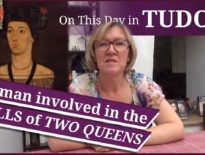On this day in Tudor history, 29th April 1567 (some sources suggest 26th), James Hepburn, Earl of Bothwell, who had recently abducted and allegedly "ravished" Mary, Queen of Scots, had a suit of divorce made against him by his wife, Lady Jean Gordon.
Lady Gordon was persuaded by Bothwell to make this divorce suit as he was planning to marry Mary, Queen of Scots, which he did on 15th May 1567.
In this talk, I explain what led up to this day, what happened next, and also what a truly horrible man Bothwell was.
Here are the videos mentioned in the talk:
Also on this day in Tudor history, 29th April 1617, Sir Dru Drury, a man who went from being a prisoner to being Lieutenant of the Tower of London, died in his 80s at his home. Find out more in last year’s video:
And on this day in 1536, in the lead up to her fall, Queen Anne Boleyn had encounters with two courtiers who would eventually be executed for allegedly sleeping with her and plotting with her to kill King Henry VIII. Find out more in the video for 29th April 1536:
Also on this day in history:
- 1500 – Birth of William Dacre, 3rd Baron Dacre of Gilsland and 7th Baron Greystoke. He was the eldest son of Thomas Dacre, 2nd Baron of Gilsland, and Elizabeth Greystoke, Baroness Greystoke. He was married twice, to Lady Elizabeth Talbot and then to Anne Hastings. His offices included Captain of Norham Castle, Steward of Penrith, Warden of the West Marches, Governor of Carlisle and Warden of the Middle Marches. He died on 18th November 1563.
- 1579 – Death of Richard Cheyney, Bishop of Gloucester, at The Lodge in Painswick, Gloucestershire, the bishop's manor. He was buried in his cathedral.
- 1594 – Death of Thomas Cooper, Bishop of Winchester and theologian, at Winchester. He was buried in his cathedral, on the south side. Cooper's works included “Cooper's Chronicle”, Thesaurus Linguae Romanae et Britannicae and “An Admonition to the People of England”, which was directed against Puritans.
Transcript:
On this day in Tudor history, 29th April 1567 (some sources suggest 26th), James Hepburn, Earl of Bothwell, who had recently abducted Mary, Queen of Scots, had a suit of divorce made against him by his wife, Jean Gordon.
Following the murder of her second husband, Henry Stuart, Lord Darnley, in Kirk o’Field, Edinburgh, on 10th February 1567, and subsequent investigations into the role of Bothwell in this dastardly deed, Mary made several visits to Seton, the home of Lord Seton, which was eleven miles east of Edinburgh. She went there to enjoy the better air, allegedly on the advice of her physicians. However, she was also spending time with the man suspected of arranging Darnley’s murder. On her third visit there, on 4th April, according to her biographer John Guy, Mary was taking a walk in the garden on the arm of Bothwell when an elderly man who was a former servant to Lord Darnley, approached her and asked her for some help to ease his situation of poverty. Before Mary had chance to do anything, Bothwell shouted at the man and launched a vicious attack on him. The man was able to limp home, but died two hours later. Bothwell was not a nice man.
Bothwell was tried for the murder of Lord Darnley at the Senate House of Edinburgh on 12th April 1567, but no evidence was submitted, and, after a trial of over eight hours, Bothwell was acquitted and, for days later, he was bearing the sceptre on his way to Parliament. Another show of aggression came from Bothwell at Holyrood on 20th April when soldiers in the great hall began to mutiny because they hadn’t been paid. Bothwell grabbed their captain by the throat before he was forced to let go and then Mary intervened and paid the men.
On 21st April 1567, Mary rode to Stirling Castle to fetch her son, the future King James VI, but the Earl of Mar refused to let her take the prince for fear of Bothwell taking control of the boy. Mary left emptyhanded on 23rd and rode to Linlithgow, where she spent the night. On 24th April 1567, she was just a few miles outside of Edinburgh, on her way back to Holyrood, when she was accosted by Bothwell who jumped out, took her horse’s bridle, ordered her servants to ride on to Edinburgh, and then forcibly and against her will took her to Dunbar Castle, where, according to Mary’s privy council in a later meeting, he ravished her and kept her captive.
Bothwell wanted to marry Mary, but he was already married. He began a suit of divorce against his wife on the grounds of consanguinity in the Catholic Court, and his wife, Lady Jean Gordon, at Bothwell’s bidding, began a suit on the grounds of adultery in the Protestant court. Bothwell actually arranged for his wife to lodge her suit. Bothwell admitted to committing adultery with his wife’s maid, Bessie Crawford, and the divorce was granted by the Protestant court on 3rd May, and then the Catholic court, at Mary’s request, granted the divorce on 7th May.
On 12th May, Mary pardoned Bothwell for kidnapping her and made him Duke of Orkney and Lord of Shetland. The couple married on 15th May 1567.



Leave a Reply